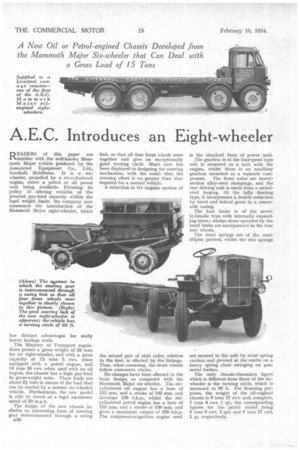A.E.C. Introduces an Eight-wheeler
Page 40

If you've noticed an error in this article please click here to report it so we can fix it.
READERS of this paper are familiar with the well-known Mammoth Major vehicle produced by the Associated Equipment Co., Ltd., Southall, Middlesex. It is a sixwheeler, propelled by a six-cyliudered engine, either a petrol or oil power unit being available. Pursuing its policy of offering vehicles of the greatest pay-load capacity within the legal weight limits, the company now announces the introduction of the Mammoth Major eight-wheeler, which
has distinct advantages for really heavy haulage work.
The Ministry of Transport regulations permit a gross weight of 22 tons for an eight-wheeler, and with a gross capacity of 15 tons 3 cwt. when equipped with a petrol engine, and 14 tons 16 cwt. when used with an oil engine, the chassis has a high pay-load to gross-weight ratio. These loads are about 2i tons in excess of the load that can be carried by a normal six-wheeled vehicle. Fnrthermore, the new model is able to travel at a legal maximum speed of 20 m.p.h.
The design of the new chassis includes an interesting form of steering gear interconnected through a swing B30 link, so that all four front wheels steer together and give an exceptionally good turning circle. Much care has been displayed in designing the steering mechanism, with the result that the steering effort is no greater than that required for a normal vehicle.
A reduction in the angular motion of the second pair of stub axles, relative to the first, is effected by the linkage. Thus, when cornering, the front wheels follow concentric circles.
No changes have been effected in the basic design, as compared with the Mammoth Major six-wheeler. The sixcylindered oil engine has a bore of 115 mm and a stroke of 142 mm. and develops 130 b.h.p., whilst the sixcylindered petrol engine has a bore of 110 mm. and a stroke of 130 min. and gives a maximum output of 120 b.h.p. The compression-ignition engine used is the standard form of power unit.
,The gearbox is of the four-speed type and is mounted as a unit with the engine, whilst there is an auxiliary gearbox mountedas a separate component. The front axles are heavysection alloy-steel stampings, and the rear driving axle is made from a nickelsteel forging. 01 the fully floating type, it incorporates a double reduction by bevel and helical gears in a removable casing.
The foot brake is of' the servohydraulic type with internally expanding shoes; similar shoes operated by the hand brake are incorporated in the four rear wheels..
The front springs are of the semielliptic pattern, whilst the rear springs are secured to the axle by stout spring carriers and pivoted at the centre on a heavy spring chair swinging on gunmetal bushes.
The only chassis-dimension figure which is different from those of the sixwheeler is the turning circle, which is increased to 66 ft. For licensing purposes, the weight of the oil-engined chassis is 6 tons 17 cwt. and, complete, 7 tons 4 cwt., 1 qr., the corresponding figures for the petrol model being 6 tons 9 cwt. 3 qrs. and 6 tons 17 cwt. 1 qr. respectively.




















































































